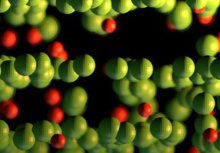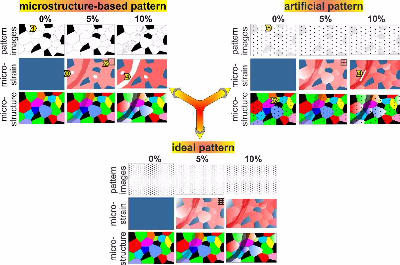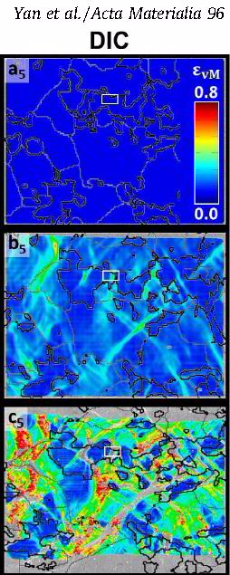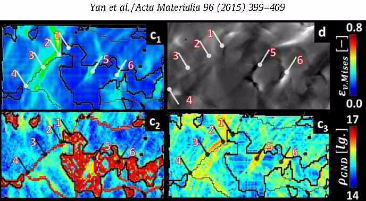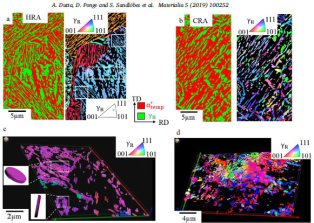Digital Image Corralation (DIC) for Multiphase Alloys and Dual Phase Steels
Introduction to Digital Image Correlation
Probing of displacement fields and the calculation of the associated deformation tensor components of the plastic strain field after deformation can be conducted by Digital Image Correlation (DIC).
Digital Image Correlation (DIC) is a digital image analysis method which is based on the recognition of kinematic changes in the gray scale or surface feature distribution of surface patterns before and after a series of subsequent straining steps. Both, the natural characteristics of an unprepared sample surface or an artificial (stochastic) color spray applied to a polished sample surface can be used as input and reference pattern.
In order to measure the three dimensional surface coordinates digital stereo pair images of the sample are acquired from these patterns before and after straining using two high resolution CCD cameras.
Details on the basic methodology of Digital Image Correlation (DIC) can be found here.
Why applying Digital Image Correlation to Dual Phase Steels?
The microstructures of dual-phase alloys such as ferrite-martensite dual-phase steels undergo complex morphological and crystallographic changes
upon deformation. These effects are visible through the associated microstructural strain fields. The multiple length and time scales involved
therein create a certain complexity, especially when microstructural damage mechanisms occur.
Therefore, better understanding of the relationship between microstructure and damage initiation can often not be achieved by post-mortem microstructural characterization alone.
Our group has therefore introduced a novel multi-probe Digital Image Correlation and coupled ICME analysis approach. It combines various scanning electron microscopy methods to microscopic-digital image correlation (µ-DIC), to
overcome various challenges associated with concurrent mapping of the deforming microstructure along with the associated microstrain fields.
What is Microscopic Digital Image Correlation (µ-DIC, Micro-DIC) ?
Our recently introduced multi-probe microscopic Digital Image Correlation combines different types of scanning electron microscopy probing techniques such as EBSD, 3D EBSD and ECCI with microscopic-digital image correlation (µ-DIC), to map deformation microstructures and the associated microstrain fields in complex alloys.
For this purpose a contrast- and resolution-optimized µ-DIC pattern method and a selective pattern/microstructure imaging strategy were developed.
They jointly enable imaging of
(i) microstructure-independent pattern maps and
(ii) pattern-independent microstructure maps.
We apply this approach here to the study of damage nucleation in ferrite/martensite dual-phase (DP) steel. It reveals that for most damage mechanisms, the level of local stress is more critical than the local strain. The analyses also provide four specific design guidelines for developing damage-resistant DP steels.
Why devloping multiphase alloys?
The quest for devloping materials with both, high strength and ductility motivates the design of novel alloys with complex, multi-phase micro-/nano-structures. Many of these alloys are microstructurally complex, containing multiple phases of different composition, crystallography, morphology, dispersion, stability and size.
Examples of metallurgical multiphase alloys
Examples of advanced multiphase alloys are ultrafine-grained α/α’ dual-phase (DP) steels, α’/γ transformation-induced plasticity (TRIP) steel, weight reduced and Triplex steels, TRIP-maraging steel, α’/γ High Entropy Aloys (HEA), β/α titanium alloys and α/X magnesium alloys.
Such alloys present a composite-like micro-mechanical response, which in turn enables tuning optimal combinations of strength and ductility by adjusting the phase fractions as well their individual properties, interfaces and morphology.
What is the main challenge associated with multiphase alloys?
Incorporating phases of high mechanical contrast promotes the risk of micro-cracking at spots of high stress and / or strain mismatch. This in turn may cause early mechanical softening, or even catastrophic failure. Due to these reasons, damage evolution has been intensively studied in recent years especially in multiphase alloys.
Damage Evolution in Dual Phase Steels
Most common damage sites in DP steels are the martensite/ferrite interfaces (M/F) or martensite island interiors. However, there are different views on exactly how these mechanisms nucleate and
interact with each other. Kang and Avramovic reported that the early-stage damage incidents are initiated inside martensite prior to percolative plastic instability, while other damage
mechanisms are activated following such mesoscale localization phenomena. However, Avramovic also noted that martensite / ferrite interface damage incidents play a more critical role
for the overall properties. Maire et al. observed a more balanced damage activity of martensite / ferrite interfaces and martensite. Recently, Hoefnagels et al. have carried out an
extensive analysis through quantitative characterization of the influence of the starting microstructure, strain path and strain level on the resulting damage mechanisms. The obtained experimental
and simulation results were explained in terms of a hypothesis that proposes that the two mechanisms are intrinsically coupled, i.e., the martensite / ferrite interface damage
incidents are typically initiated by martensite cracking.
These contradicting views arise from the insufficient resolution in the analysis of deformation and damage at the same position, with respect to their strong heterogeneity at microstructure-scale.
Thus, it is required to introduce novel analysis methods, which make use of advanced high resolution probing techniques of micro-mechanical processes during deformation. However, this is an
experimental task that imposes multiple challenges, as it requires the simultaneous mapping of the deformation-induced evolution of the
(i) microstructure,
(ii) microstrain and
(iii) microstress fields
at a representatively large field-of-view and yet, a sufficiently high spatial resolution.
Here, we present new insights into damage nucleation in DP steels by developing a novel methodology that overcomes challenges (i) and (ii). This methodology combines in-situ scanning electron
microscopy (SEM) testing with optimized microscopic-digital image correlation (μ-DIC) analysis.
References:
C.C. Tasan, M. Diehl, D. Yan, C. Zambaldi, P. Shanthraj, F. Roters, D. Raabe, Integrated experimental-simulation analysis of stress and strain partitioning in multiphase alloys. Acta Materialia 81 (2014) 386-400.
C.C. Tasan, J.P.M. Hoefnagels, M. Diehl, D. Yan, F. Roters, D. Raabe, Strain localization and damage in dual phase steels investigated by coupled in-situ deformation experiments and crystal plasticity simulations. International Journal of Plasticity 63 (2014) 198-210.
D. Yan, C.C. Tasan, D. Raabe, High resolution in situ mapping of microstrain and microstructure evolution reveals damage resistance criteria in dual phase steels. Acta Materialia 96 (2015) 399-409.
C.C. Tasan, M. Diehl, D. Yan, M. Bechtold, F. Roters, L. Schemmann, C. Zheng, N. Peranio, D. Ponge, M. Koyama, K. Tsuzaki, and D. Raabe, An Overview of Dual-Phase Steels: Advances in Microstructure-Oriented Processing and Micromechanically Guided Design. Annual Review of Materials Research Vol. 45: 391-431 (July 2015)
Strain partitioning and strain localization in medium manganese steels observed by in-situ microscopic digital image correlation
In this project we used in situ microscopic-digital image correlation (μ-DIC) for investigating the strain partitioning and strain localization behavior in a medium manganese steel. Continuous yielding results from strain partitioning with higher strain in the reverted austenite ( ?R ) islands and less strain in the tempered martensite ( α′temp ) matrix, both in hot and cold rolled material. μ-DIC experiments are performed to further understand the effects of texture and grain morphology on strain partitioning which cannot be locally resolved through high resolution x-ray or neutron diffraction experiments. Apart from strain partitioning, strain localization is observed in hot rolled samples within colonies of lamellar ?R islands. This localization does not only depend on the crystallographic orientation, but also on the spatial alignment of an austenite island relative to the loading direction. The effects of texture, spatial and colony alignment are interpreted within the concept of a relative grain size effect resulting in different yield stresses in the hot and cold rolled samples showing continuous yielding. Strain partitioning and strain localization based on texture and spatial alignment can be extended to numerous dual phase morphologies with similar texture, colony and spatial alignment effects.
Materialia 5 (2019) 100252
Fe Strain partitioning medium Mn steel D[...]
PDF-Dokument [6.3 MB]
Further reading about the use of Digital Image Corralation (DIC) for Dual Phase Steels
High resolution in situ mapping of microstrain and microstructure evolution reveals damage resistance criteria in dual phase steels
Acta Materialia 96 (2015) 399-409
Dingshun Yan, Cemal Cem Tasan, Dierk Raabe
Acta Materialia 96 (2015) 399 Yan Tasan [...]
PDF-Dokument [1.7 MB]
Microstructures of multi-phase alloys undergo morphological and crystallographic changes upon deformation, corresponding to the associated microstructural strain fields. The multiple length
and time scales involved therein create immense complexity, especially when microstructural damage
mechanisms are also activated. An understanding of the relationship between microstructure and damage initiation can often not be achieved by post-mortem microstructural characterization
alone. Here, we present a novel multi-probe analysis approach. It couples various scanning electron microscopy
methods to microscopic-digital image correlation (l-DIC), to overcome various challenges associated with concurrent mapping of the deforming microstructure along with the associated
microstrain fields. For this purpose a contrast- and resolution-optimized l-DIC patterning method and a selective pattern / microstructure imaging strategy were developed. They jointly enable
imaging of (i) microstructure-independent pattern maps and (ii) pattern-independent microstructure maps. We apply this approach here to the study of damage nucleation in ferrite/martensite
dual-phase (DP) steel. The analyses provide four specific design guidelines for developing damage-resistant DP steels.
Integrated experimental–simulation analysis of stress and strain partitioning in multiphase alloys
Acta Materialia 81 (2014) 386-400
C.C. Tasan, M. Diehl, D. Yan, C. Zambaldi, P. Shanthraj, F. Roters, D. Raabe
Tasan et al Acta Materialia vol 91 2014 [...]
PDF-Dokument [3.4 MB]
The mechanical response of multiphase alloys is governed by the microscopic strain and stress partitioning behavior among microstructural constituents. However, due to limitations in the
characterization of the partitioning that takes place at the submicron scale, microstructure optimization of such alloys is typically based on evaluating the averaged response, referring to, for
example, macroscopic stress–strain curves. Here, a novel experimental–numerical methodology is introduced to strengthen the integrated understanding of the
microstructure and mechanical properties of these alloys, enabling joint analyses of deformation-induced evolution of the microstructure, and the strain and stress distribution therein, down to
submicron resolution. From the experiments, deformation-induced evolution of (i) the microstructure, and (ii) the local strain distribution are concurrently captured, employing in situ secondary
electron imaging and electron backscatter diffraction (EBSD) (for the former), and microscopic-digital image correlation (for the latter). From the simulations,
local strain as well as stress distributions are revealed, through 2-D full-field crystal plasticity (CP) simulations conducted with an advanced spectral solver suitable for heterogeneous
materials. The simulated model is designed directly from the initial EBSD measurements, and the phase properties are obtained by additional inverse CP simulations of nanoindentation experiments
carried out on the original microstructure. The experiments and simulations demonstrate good correlation in the proof-of-principle study conducted here on a martensite–ferrite dual-phase
steel, and deviations are discussed in terms of limitations of the techniques involved. Overall, the presented integrated computational materials engineering approach provides a vast amount of
well-correlated structural and mechanical data that enhance our understanding as well as the design capabilities of multiphase alloys.
Overview of Dual-Phase Steels: Advances in Microstructure-Oriented Processing and Micromechanically Guided Design
Annual Review of Materials Research Vol. 45: 391-431 (July 2015)
C.C. Tasan, M. Diehl, D. Yan, M. Bechtold, F. Roters, L. Schemmann, C. Zheng, N. Peranio, D. Ponge, M. Koyama, K. Tsuzaki, and D. Raabe
Annu. Rev. Mater. Res. 2015 vol 45 page[...]
PDF-Dokument [4.2 MB]
Dual-phase (DP) steels are a key class of advanced high-strength steels, which
were the first among various candidate alloy systems to find application in
weight-reduced automotive components. On the one hand, this is a metal-
lurgical success story: Lean alloying and simple thermomechanical treatment
enable use of less material to accomplish more performance while comply-
ing with demanding environmental and economic constraints. On the other
hand, the enormous literature onDP steels demonstrates the immense com-
plexity ofmicrostructure physics inmultiphase alloys: Roughly 50 years after
the first reports on ferrite-martensite steels, there are still various open sci-
entific questions. Fortunately, the last decades witnessed enormous advances
in the development of enabling experimental and simulation techniques, sig-
nificantly improving the understanding of DP steels. This review provides
a detailed account of these improvements, focusing specifically on (a) mi-
crostructure evolution during processing, (b) experimental characterization
of micromechanical behavior, and (c) the simulation of mechanical behavior,
to highlight the critical unresolved issues and to guide future research efforts.
Overview of strain localization and damage in dual phase steels investigated by coupled in-situ deformation experiments and crystal plasticity simulations
International Journal of Plasticity 63 (2014) 198-210
C.C. Tasan, J.P.M. Hoefnagels, M. Diehl, D. Yan, F. Roters, D. Raabe
Intern Journal Plasticity 63 (2014) 198 [...]
PDF-Dokument [5.5 MB]
Ferritic–martensitic dual phase (DP) steels deform spatially in a highly heterogeneous manner, i.e. with strong strain and stress partitioning at the micro-scale. Such heterogeneity in
local strain evolution leads in turn to a spatially heterogeneous damage distribution, and thus, plays an important role in the process of damage inheritance and fracture. To understand and
improve DP steels, it is important to identify connections between the observed strain and damage heterogeneity and the underlying microstructural parameters, e.g. ferrite grain size,
martensite distribution, martensite fraction, etc. In this work we
pursue this aim by conducting in-situ deformation experiments on two different DP steel grades, employing two different microscopic-digital image correlation (lDIC) techniques to achieve
microstructural strain maps of representative statistics and high-resolution. The resulting local strain maps are analyzed in connection to the observed damage incidents (identified by
image post-processing) and to local stress maps (obtained from crystal plasticity (CP) simulations of the same microstructural area). The results reveal that plasticity
is typically initiated within ‘‘hot zones’’ with larger ferritic grains and lower local
martensite fraction. With increasing global deformation, damage incidents are most often observed in the boundary of such highly plastified zones. High-resolution lDIC and the corresponding
CP simulations reveal the importance of martensite dispersion: zones with bulky martensite are more susceptible to macroscopic localization before the full strain hardening capacity of the
material is consumed. Overall, the presented joint analysis establishes an integrated computational materials engineering (ICME) approach for designing advanced DP steels.
